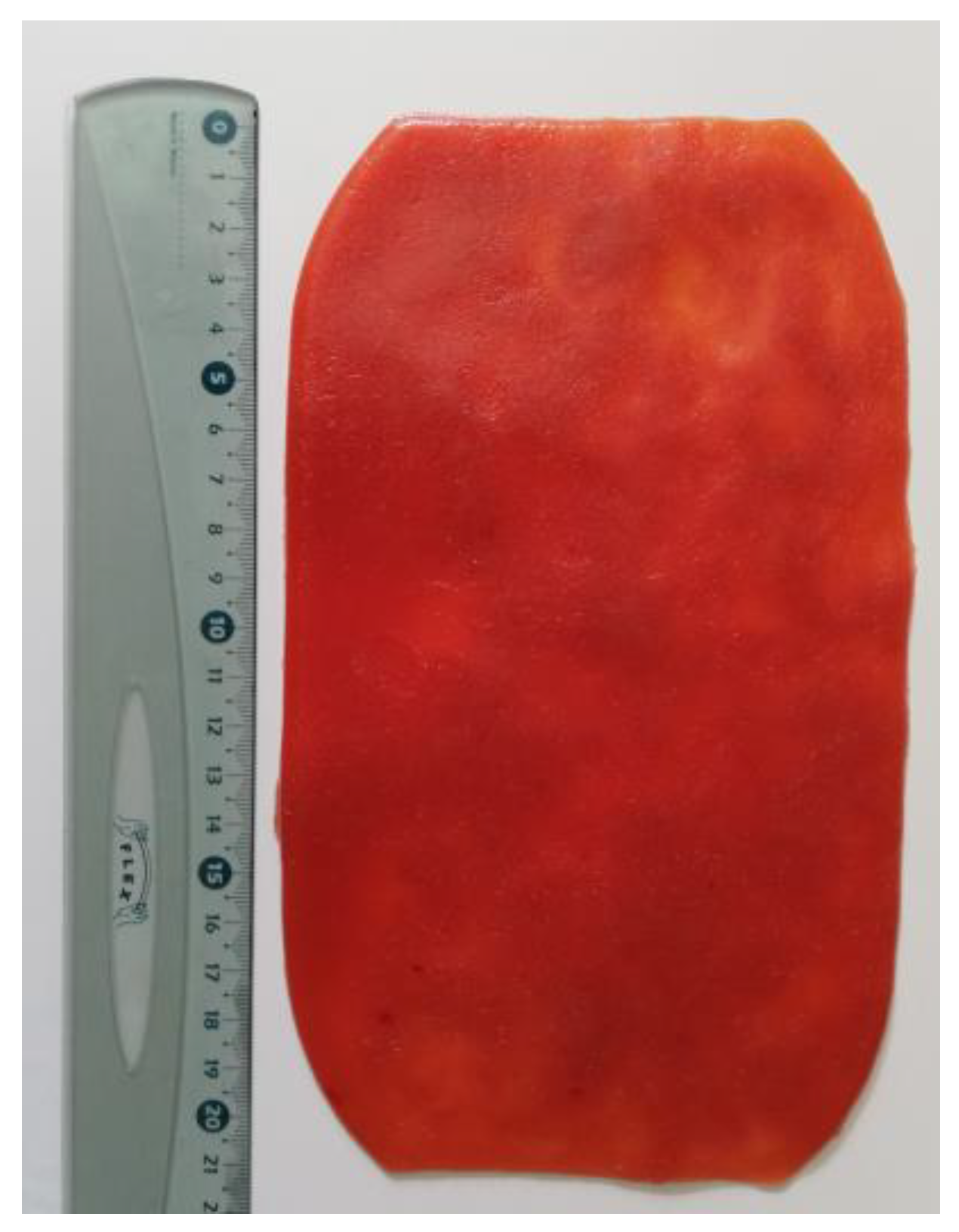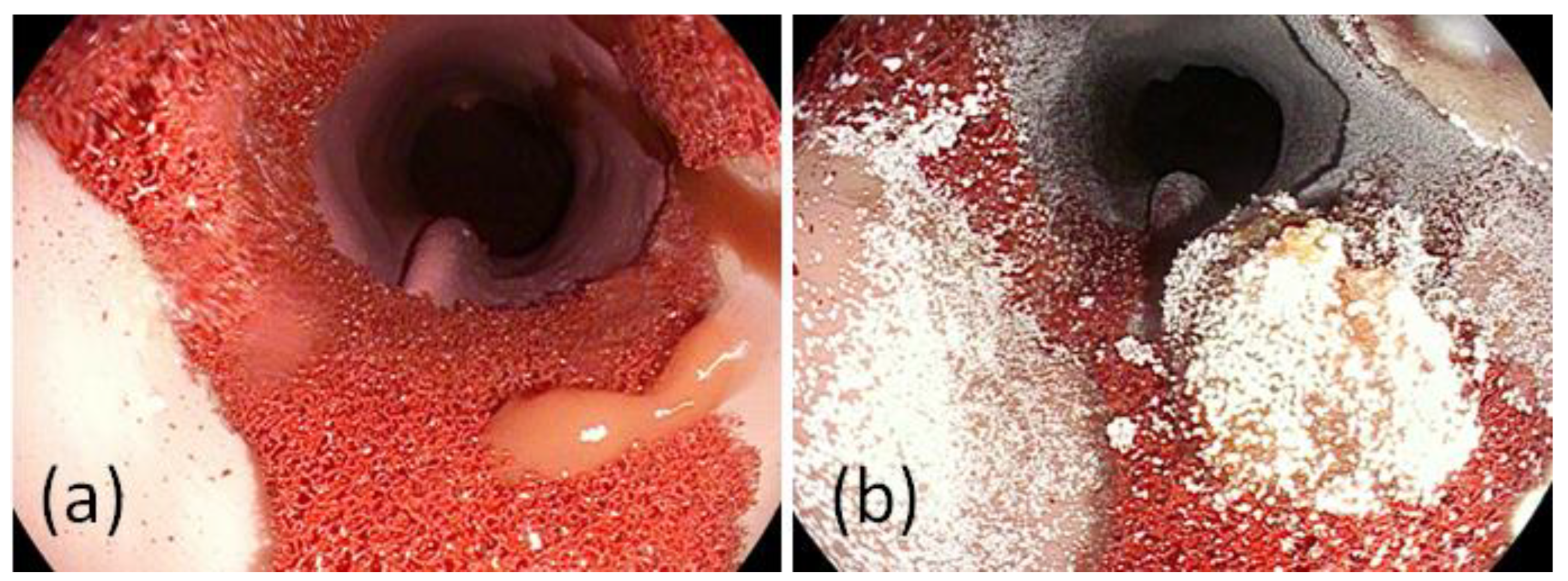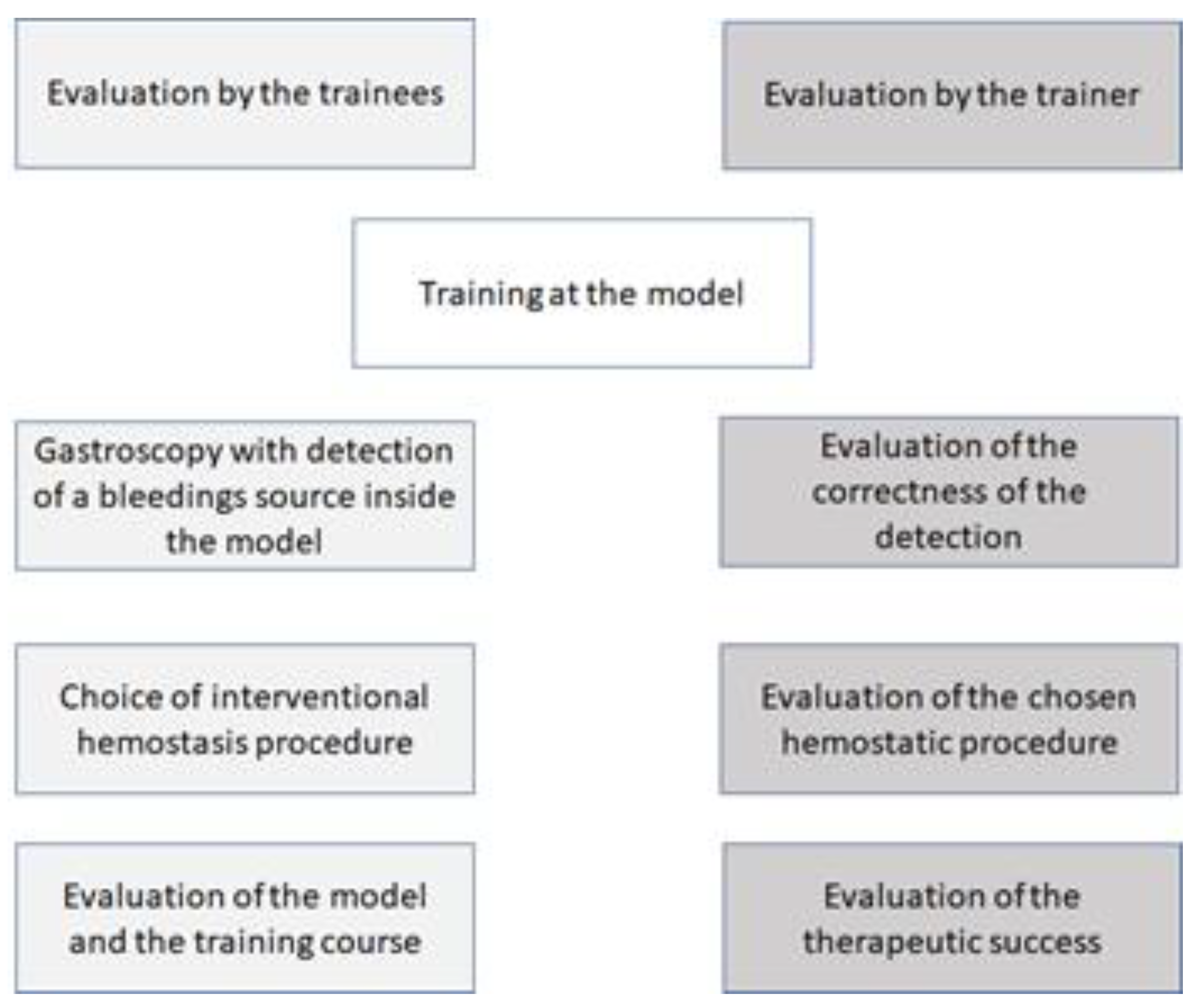Evaluation of a New Animal Tissue-Free Bleeding Model for Training of Endoscopic Hemostasis
Abstract
1. Introduction
2. Materials and Methods
- (a)
- Gastric and duodenal ulcers bleeding
- (b) Esophageal variceal bleeding
- (c) Bleeding out of erosive reflux esophagitis
- (d) Modular exchangeable model
- (e) Evaluation
- (f) Statistics
3. Results
4. Discussion
5. Conclusions
Author Contributions
Funding
Institutional Review Board Statement
Informed Consent Statement
Data Availability Statement
Acknowledgments
Conflicts of Interest
References
- Vora, P.; Pietila, A.; Peltonen, M.; Brobert, G.; Salomaa, V. Thirty-Year Incidence and Mortality Trends in Upper and Lower Gastrointestinal Bleeding in Finland. JAMA Netw. Open 2020, 3, e2020172. [Google Scholar] [CrossRef] [PubMed]
- Gotz, M.; Anders, M.; Biecker, E.; Bojarski, C.; Braun, G.; Brechmann, T.; Dechene, A.; Dollinger, M.; Gawaz, M.; Kiesslich, R.; et al. S2k Guideline Gastrointestinal Bleeding—Guideline of the German Society of Gastroenterology DGVS. Z. Gastroenterol. 2017, 55, 883–936. [Google Scholar] [CrossRef] [PubMed]
- Ekkelenkamp, V.E.; Koch, A.D.; de Man, R.A.; Kuipers, E.J. Training and competence assessment in GI endoscopy: A systematic review. Gut 2016, 65, 607–615. [Google Scholar] [CrossRef] [PubMed]
- Desilets, D.J.; Banerjee, S.; Barth, B.A.; Kaul, V.; Kethu, S.R.; Pedrosa, M.C.; Pfau, P.R.; Tokar, J.L.; Varadarajulu, S.; Wang, A.; et al. Endoscopic simulators. Gastrointest. Endosc. 2011, 73, 861–867. [Google Scholar] [CrossRef] [PubMed]
- Cha, J.M.; Lee, J.I.; Joo, K.R.; Shin, H.P.; Park, J.J.; Jeon, J.W.; Lim, J.U.; Lym, K. The box simulator is useful for training novice endoscopists in basic endoscopic techniques. Yonsei Med. J. 2012, 53, 304–309. [Google Scholar] [CrossRef] [PubMed]
- Cohen, J.; Cohen, S.A.; Vora, K.C.; Xue, X.; Burdick, J.S.; Bank, S.; Bini, E.J.; Bodenheimer, H.; Cerulli, M.; Gerdes, H.; et al. Multicenter, randomized, controlled trial of virtual-reality simulator training in acquisition of competency in colonoscopy. Gastrointest. Endosc. 2006, 64, 361–368. [Google Scholar] [CrossRef] [PubMed]
- Cohen, J. Simulation training in endoscopy. Gastroenterol. Hepatol. 2008, 4, 25–27. [Google Scholar]
- Grund, K.E.; Schweizer, U.; Zipfel, A.; Mothes, B. Learning of flexible endoscopy, particularly endoscopic vacuum therapy (EVT). Chirurg 2018, 89, 977–983. [Google Scholar] [CrossRef] [PubMed]
- Breuer, G. Training—Competency-based education—Learning theory and practice. Anasthesiol. Intensiv. Notf. Schmerzther 2013, 48, 708–713. [Google Scholar] [CrossRef]
- Armbruster, W.; Kubulus, D.; Schlechtriemen, T.; Adler, J.; Hohn, M.; Schmidt, D.; Duchene, S.; Steiner, P.; Volk, T.; Wrobel, M. Improvement of emergency physician education through simulator training. Consideration on the basis of the model project “NASimSaar25”. Anaesthesist 2014, 63, 691–696. [Google Scholar] [CrossRef] [PubMed]
- Flentje, M.; Eismann, H.; Sieg, L.; Hagemann, V.; Friedrich, L. Impact of Simulator-Based Crisis Resource Management Training on Collective Orientation in Anaesthesia: Pre-Post Survey Study with Interprofessional Anaesthesia Teams. J. Med. Educ. Curric. Dev. 2020, 7, 2382120520931773. [Google Scholar] [CrossRef] [PubMed]
- Haycock, A.V.; Youd, P.; Bassett, P.; Saunders, B.P.; Tekkis, P.; Thomas-Gibson, S. Simulator training improves practical skills in therapeutic GI endoscopy: Results from a randomized, blinded, controlled study. Gastrointest. Endosc. 2009, 70, 835–845. [Google Scholar] [CrossRef] [PubMed]
- Hochberger, J.; Matthes, K.; Maiss, J.; Koebnick, C.; Hahn, E.G.; Cohen, J. Training with the compactEASIE biologic endoscopy simulator significantly improves hemostatic technical skill of gastroenterology fellows: A randomized controlled comparison with clinical endoscopy training alone. Gastrointest. Endosc. 2005, 61, 204–215. [Google Scholar] [CrossRef] [PubMed]
- Maiss, J.; Prat, F.; Wiesnet, J.; Proeschel, A.; Matthes, K.; Peters, A.; Hahn, E.G.; Sautereau, D.; Chaussade, S.; Hochberger, J. The complementary Erlangen active simulator for interventional endoscopy training is superior to solely clinical education in endoscopic hemostasis—The French training project: A prospective trial. Eur. J. Gastroenterol. Hepatol. 2006, 18, 1217–1225. [Google Scholar] [CrossRef] [PubMed]
- Maiss, J.; Wiesnet, J.; Proeschel, A.; Matthes, K.; Prat, F.; Cohen, J.; Chaussade, S.; Sautereau, D.; Naegel, A.; Krauss, N.; et al. Objective benefit of a 1-day training course in endoscopic hemostasis using the “compactEASIE” endoscopy simulator. Endoscopy 2005, 37, 552–558. [Google Scholar] [CrossRef] [PubMed]







| Layer | Material | Manufacturer |
|---|---|---|
| Mucosal | Volulyte 6% infusion fluid | Fresenius Kabi Deutschland GmbH, Bad Homburg, Germany |
| Kokonte-Lafu (Cassava Flour) | Praise Export Services Limited, Taifa-Burkina, Accra, Ghana | |
| Tapioca starch | Farmer Brand, Bangkok, Thailand | |
| Natriumchloride | VWR International GmbH, Bruchsal, Germany | |
| Cotton | dm-drogerie markt GmbH + Co. KG, Karlsruhe, Germany | |
| Red food coloring | Brauns-Heitmann GmbH + Co. KG, Wahrburg, Germany | |
| Vaseline | dm-drogerie markt GmbH + Co. KG, Karlsruhe, Germany | |
| Cling film | Melitta Unternehmensgruppe Bentz KG, Minden, Germany | |
| Submucosal | Aquacel Extra (10 cm × 10 cm) | ConvaTec Group plc, Deeside, United, Kingdom |
| Tights 40 den | dm-drogerie markt GmbH + Co. KG, Karlsruhe, Germany | |
| Schauch Superabsorber (Art.-Nr. 397) | ElaDe.de, Lauffen am Neckar, Germany |
| Bleeding Source | Treatment Modality |
|---|---|
| Variceal bleeding | Ligation therapy |
| Gastric ulcer bleeding | TTSC, OTSC, injection therapy |
| Duodenal ulcer bleeding | TTSC, OTSC, injection therapy |
| Erosive esophagitis with bleeding | Topic hemostatic powder |
| Sociometric Items | Number of Participants (%) |
|---|---|
| Age | |
| <30 years | 9 (24%) |
| 30–45 years | 23 (60%) |
| >46 years | 6 (16%) |
| Male Sex | 26 (68%) |
| Level of education | |
| Assistant physician | 17 (45%) |
| Medical specialist | 5 (13%) |
| Senior physician | 10 (26%) |
| no information | 6 (16%) |
| Level of knowledge | |
| number of elective gastroscopies 0–50 | 13 (34%) |
| number of elective gastroscopies 51–250 | 9 (24%) |
| number of elective gastroscopies > 251 | 15 (39%) |
| no information | 1 (3%) |
| bleeding gastroscopies 0–20 | 18 (47%) |
| bleeding gastroscopies 21–50 | 5 (13%) |
| bleeding gastroscopies 51–100 | 14 (37%) |
| no information | 1 (3%) |
| Parameter | Mean School Grade | ||
|---|---|---|---|
| Total | Assistant Physician (n = 17) | Medical Specialists, Senior Physicians and Others (n = 21) | |
| Importance of training in endoscopy for bleeding situations | 1.6 | 1.3 | 1.9 |
| Suitability of the model for endoscopic training for bleeding treatment | 1.4 | 1.2 | 1.8 |
| Model in general | |||
| Overall grade | 1.7 | 1.4 | 2.2 |
| Optic | 1.5 | 1.3 | 1.8 |
| Haptic | 2.0 | 1.6 | 2.3 |
| Gastric and duodenal ulcer | |||
| Submucosal wheal | 1.8 | 1.7 | 2.0 |
| Application ground for the TTSC | 1.8 | 1.5 | 2.4 |
| Application ground for the OTSC | 1.4 | 1.3 | 1.7 |
| Success of therapy | 1.5 | 1.2 | 1.7 |
| Erosive esophagitis | |||
| Hemostatic powder | 1.6 | 1.2 | 2.7 |
| Success of therapy | 1.6 | 1.4 | 2.7 |
| Variceal bleeding | |||
| Banding ligation | 2.3 | 1.5 | 2.8 |
| Success of therapy | 2.3 | 1.0 | 2.8 |
Disclaimer/Publisher’s Note: The statements, opinions and data contained in all publications are solely those of the individual author(s) and contributor(s) and not of MDPI and/or the editor(s). MDPI and/or the editor(s) disclaim responsibility for any injury to people or property resulting from any ideas, methods, instructions or products referred to in the content. |
© 2023 by the authors. Licensee MDPI, Basel, Switzerland. This article is an open access article distributed under the terms and conditions of the Creative Commons Attribution (CC BY) license (https://creativecommons.org/licenses/by/4.0/).
Share and Cite
Wichmann, D.; Grether, S.; Fundel, J.; Schweizer, U.; Wedi, E.; Walter, B.; Königsrainer, A.; Duckworth-Mothes, B. Evaluation of a New Animal Tissue-Free Bleeding Model for Training of Endoscopic Hemostasis. J. Clin. Med. 2023, 12, 3230. https://doi.org/10.3390/jcm12093230
Wichmann D, Grether S, Fundel J, Schweizer U, Wedi E, Walter B, Königsrainer A, Duckworth-Mothes B. Evaluation of a New Animal Tissue-Free Bleeding Model for Training of Endoscopic Hemostasis. Journal of Clinical Medicine. 2023; 12(9):3230. https://doi.org/10.3390/jcm12093230
Chicago/Turabian StyleWichmann, Dörte, Sarah Grether, Jana Fundel, Ulrich Schweizer, Edris Wedi, Benjamin Walter, Alfred Königsrainer, and Benedikt Duckworth-Mothes. 2023. "Evaluation of a New Animal Tissue-Free Bleeding Model for Training of Endoscopic Hemostasis" Journal of Clinical Medicine 12, no. 9: 3230. https://doi.org/10.3390/jcm12093230
APA StyleWichmann, D., Grether, S., Fundel, J., Schweizer, U., Wedi, E., Walter, B., Königsrainer, A., & Duckworth-Mothes, B. (2023). Evaluation of a New Animal Tissue-Free Bleeding Model for Training of Endoscopic Hemostasis. Journal of Clinical Medicine, 12(9), 3230. https://doi.org/10.3390/jcm12093230






